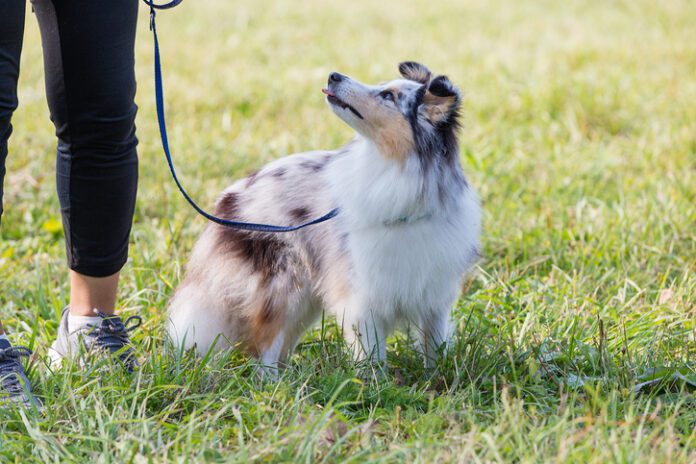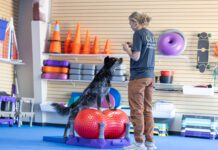Loose-leash walking, historically known as “heeling,” is one of the more challenging behaviors to master, since most walks happen away from home, where distractions abound.
Here are six keys to teaching your dog to heel:
Keep in mind that it’s harder for your dog than it looks
Without a leash, most dogs would be well ahead of their (slow!) human counterparts. They’re built to go faster – they have twice as many legs! Not to mention a nose that can smell parts per trillion. Asking a dog to walk on a loose leash is asking a dog to choose to walk slower than their natural pace while largely ignoring most of the amazing smells and other distractions they’d love to pull toward
Be willing to pay well
If we expect our dog to walk slower than his natural pace, paying less attention to the environment and more attention to us, we must make it worth his while. Dogs repeat behaviors that are reinforced. If pulling gets him closer to the smell he wants to sniff, pulling has been rewarded. When I’m teaching leash manners, I reward so quickly and frequently, the dog doesn’t have time to think about pulling – he’s too busy earning rewards by walking with me!
Create a zone of awesome
Polite leash walking is built one step at a time. Start by rewarding your dog for being next to you. Make the area that’s next to you a “zone of awesome,” where the treats and praise are free-flowing. Your dog needs to be able to stand next to you on a loose leash before he can walk next to you on a loose leash.
Start small and don’t be greedy
As your dog realizes how well it pays to stand next to you, begin adding movement – one step at a time. Reward your dog in your “zone of awesome” before he has a chance to surge ahead of you and self-reward with the fun of moving forward or reaching an enticing smell. Talk to your dog as you walk. You’re on the walk together – be a team! Polite leash walking should not look like a precise military heel. A great goal is to create a zone of awesome within the radius of your 6-foot leash.
The early days of teaching leash manners will likely look like one step > treat > one step > treat – over and over! As your dog settles into this pattern, add a second step before the treat. Sometimes surprise your dog with a treat after a single step. You might feel like a Pez dispenser but stick with it. Remember: Your dog will repeat behaviors that are reinforced. You won’t need this many treats forever, but you’ll need them for a while – likely much longer than you think. If you’re worried about using too many treats, use your dog’s kibble. In my puppy classes, I challenge my students to feed their dogs’ entire morning meal as rewards while on a morning walk.
To really stack the deck in your favor, take that morning walk in your own backyard or up and down your hallway to minimize distractions and make it easy for your dog to be successful. Help your dog get it right and work your way up from there.
You can call it whatever you want!
There’s nothing magical about the cue “heel.” As a verb, “heel” originated in the early 1800s to mean, “to follow or stop at a person’s heels,” usually on the left side. This is because most people are right-handed, and, in the case of military and hunting dogs, it keeps prevents the ejecting shells and cartridge casings from hitting the dog as they fall to the ground. If you’re a right-handed pet owner, it’s likely easier to have your dog on your left and keep your dominant hand free.
When training most new behaviors, it’s better to not name it in the beginning. Learning can be messy, and it will take your dog a while to figure things out. Naming a behavior too early carries the risk of your dog associating the cue with the messy version of the behavior. If you need to encourage your dog to start moving, pat your leg and say, “Let’s go” as you take your first step. As it becomes easier for your dog to stick with you, even around distractions, you can name the behavior. “Heel,” “Close,” “With me,” – use whatever cue works for you!
Other things to consider

Remember that polite leash walking is unnatural for dogs. As such, it’s important that we give them ample opportunities to experience the world in a more natural – to them – way. While I teach my dog to walk politely on a leash, I also offer plenty of opportunities for “sniffaries,” (a sniffing safari!) where he’s free to mostly disengage from me and sniff to his heart’s content. To avoid a tight leash during such walks, we purposefully use a long ling or walk off-leash in appropriate areas. Different types of adventure walks are important to your dog’s overall wellbeing.
There will also be plenty of times where you just need to get from Point A to Point B long before your dog has mastered his polite leash-walking skills. For those times when you need the focus to be on getting somewhere rather than training, consider using a well-fitting front-clip harness.
If you’re struggling to teach or maintain your dog’s polite leash-walking skills, you’re not alone. The world is a distracting place! It can be a difficult behavior to achieve and maintain. A skilled, positive-reinforcement trainer can offer tips and tricks to help heal your heeling and get you and four-legged friend on the path to mutually enjoyable walks and more.





